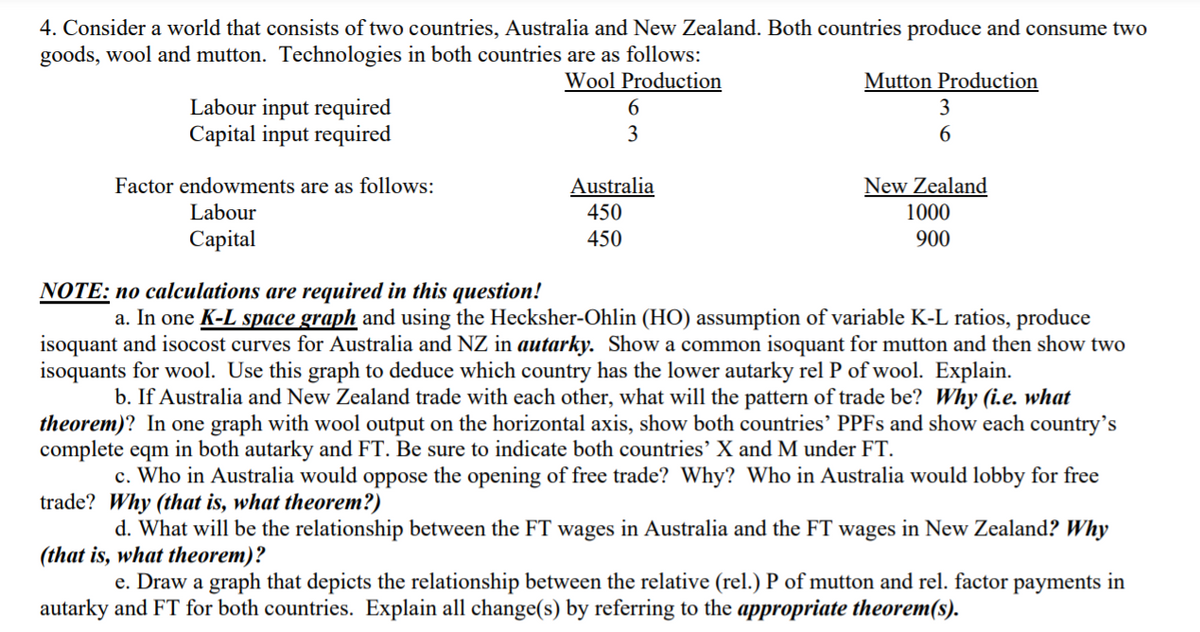4. Consider a world that consists of two countries, Australia and New Zealand. Both countries produce and consume two goods, wool and mutton. Technologies in both countries are as follows: Wool Production Mutton Production Labour input required Capital input required 3 3 6. New Zealand 1000 Factor endowments are as follows: Australia 450 Labour Сapital 450 900 NOTE: no calculations are required in this question! a. In one K-L space graph and using the Hecksher-Ohlin (HO) assumption of variable K-L ratios, produce isoquant and isocost curves for Australia and NZ in autarky. Show a common isoquant for mutton and then show two isoquants for wool. Use this graph to deduce which country has the lower autarky rel P of wool. Explain. b. If Australia and New Zealand trade with each other, what will the pattern of trade be? Why (i.e. what theorem)? In one graph with wool output on the horizontal axis, show both countries' PPFS and show each country's complete eqm in both autarky and FT. Be sure to indicate both countries' X and M under FT. c. Who in Australia would oppose the opening of free trade? Why? Who in Australia would lobby for free trade? Why (that is, what theorem?) d. What will be the relationship between the FT wages in Australia and the FT wages in New Zealand? Why (that is, what theorem)? e. Draw a graph that depicts the relationship between the relative (rel.) P of mutton and rel. factor payments in autarky and FT for both countries. Explain all change(s) by referring to the appropriate theorem(s).
4. Consider a world that consists of two countries, Australia and New Zealand. Both countries produce and consume two goods, wool and mutton. Technologies in both countries are as follows: Wool Production Mutton Production Labour input required Capital input required 3 3 6. New Zealand 1000 Factor endowments are as follows: Australia 450 Labour Сapital 450 900 NOTE: no calculations are required in this question! a. In one K-L space graph and using the Hecksher-Ohlin (HO) assumption of variable K-L ratios, produce isoquant and isocost curves for Australia and NZ in autarky. Show a common isoquant for mutton and then show two isoquants for wool. Use this graph to deduce which country has the lower autarky rel P of wool. Explain. b. If Australia and New Zealand trade with each other, what will the pattern of trade be? Why (i.e. what theorem)? In one graph with wool output on the horizontal axis, show both countries' PPFS and show each country's complete eqm in both autarky and FT. Be sure to indicate both countries' X and M under FT. c. Who in Australia would oppose the opening of free trade? Why? Who in Australia would lobby for free trade? Why (that is, what theorem?) d. What will be the relationship between the FT wages in Australia and the FT wages in New Zealand? Why (that is, what theorem)? e. Draw a graph that depicts the relationship between the relative (rel.) P of mutton and rel. factor payments in autarky and FT for both countries. Explain all change(s) by referring to the appropriate theorem(s).
Chapter2: Economic Tools And Economic Systems
Section: Chapter Questions
Problem 3.5P
Related questions
Question
Parts c and d in the attached image please

Transcribed Image Text:4. Consider a world that consists of two countries, Australia and New Zealand. Both countries produce and consume two
goods, wool and mutton. Technologies in both countries are as follows:
Wool Production
Mutton Production
Labour input required
Capital input required
3
3
6.
New Zealand
1000
Factor endowments are as follows:
Australia
450
Labour
Сapital
450
900
NOTE: no calculations are required in this question!
a. In one K-L space graph and using the Hecksher-Ohlin (HO) assumption of variable K-L ratios, produce
isoquant and isocost curves for Australia and NZ in autarky. Show a common isoquant for mutton and then show two
isoquants for wool. Use this graph to deduce which country has the lower autarky rel P of wool. Explain.
b. If Australia and New Zealand trade with each other, what will the pattern of trade be? Why (i.e. what
theorem)? In one graph with wool output on the horizontal axis, show both countries' PPFS and show each country's
complete eqm in both autarky and FT. Be sure to indicate both countries' X and M under FT.
c. Who in Australia would oppose the opening of free trade? Why? Who in Australia would lobby for free
trade? Why (that is, what theorem?)
d. What will be the relationship between the FT wages in Australia and the FT wages in New Zealand? Why
(that is, what theorem)?
e. Draw a graph that depicts the relationship between the relative (rel.) P of mutton and rel. factor payments in
autarky and FT for both countries. Explain all change(s) by referring to the appropriate theorem(s).
Expert Solution
This question has been solved!
Explore an expertly crafted, step-by-step solution for a thorough understanding of key concepts.
Step by step
Solved in 2 steps

Knowledge Booster
Learn more about
Need a deep-dive on the concept behind this application? Look no further. Learn more about this topic, economics and related others by exploring similar questions and additional content below.Recommended textbooks for you


Principles of Economics 2e
Economics
ISBN:
9781947172364
Author:
Steven A. Greenlaw; David Shapiro
Publisher:
OpenStax

Brief Principles of Macroeconomics (MindTap Cours…
Economics
ISBN:
9781337091985
Author:
N. Gregory Mankiw
Publisher:
Cengage Learning


Principles of Economics 2e
Economics
ISBN:
9781947172364
Author:
Steven A. Greenlaw; David Shapiro
Publisher:
OpenStax

Brief Principles of Macroeconomics (MindTap Cours…
Economics
ISBN:
9781337091985
Author:
N. Gregory Mankiw
Publisher:
Cengage Learning

Principles of Macroeconomics (MindTap Course List)
Economics
ISBN:
9781305971509
Author:
N. Gregory Mankiw
Publisher:
Cengage Learning

Essentials of Economics (MindTap Course List)
Economics
ISBN:
9781337091992
Author:
N. Gregory Mankiw
Publisher:
Cengage Learning

Principles of Economics, 7th Edition (MindTap Cou…
Economics
ISBN:
9781285165875
Author:
N. Gregory Mankiw
Publisher:
Cengage Learning